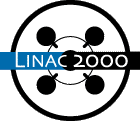
P. L. Colestock, T. Wangler, C. K. Allen, R. L. Sheffield, D. Gilpatrick, and the Diagnostics Group, M. Thuot, and the Controls Group, the LEDA Operations Team (Los Alamos National Laboratory), M. Schulze, A. Harvey (General Atomics)
Due to the potentially adverse effects of the generation of halo particles in intense proton beams, it is imperative to have a clear understanding of the mechanisms that can lead to halo formation for current and proposed high-intensity linacs. To this end a theoretical model has been developed, known as the core-halo model, which indicates that protons under the combined influence of strong space charge forces and periodic focussing in a linear transport channel can be kicked into halo orbits. However, no experimental measurements of beam halo in proton beams have yet been carried out. In this paper we report the progress of an effort to carry out an experiment to measure beam-halo using the existing high-intensity proton beam of the LEDA facility. A linear transport channel has been assembled with the appropriate diagnostics for measuring the expected small beam component in the beam halo as a function of beam parameters. The experiment is based on the use of an array of high-dynamic-range wire and beam scrapers to determine the halo and core profiles along the transport channel. Details of the experimental design, the expected halo measurement properties and first results, if available, will be presented.
[1] R. L. Gluckstern, Phys. Rev. Lett, vol. 27, 9, 29 Aug. 1994
Comments or Questions to
linac2000@slac.stanford.edu